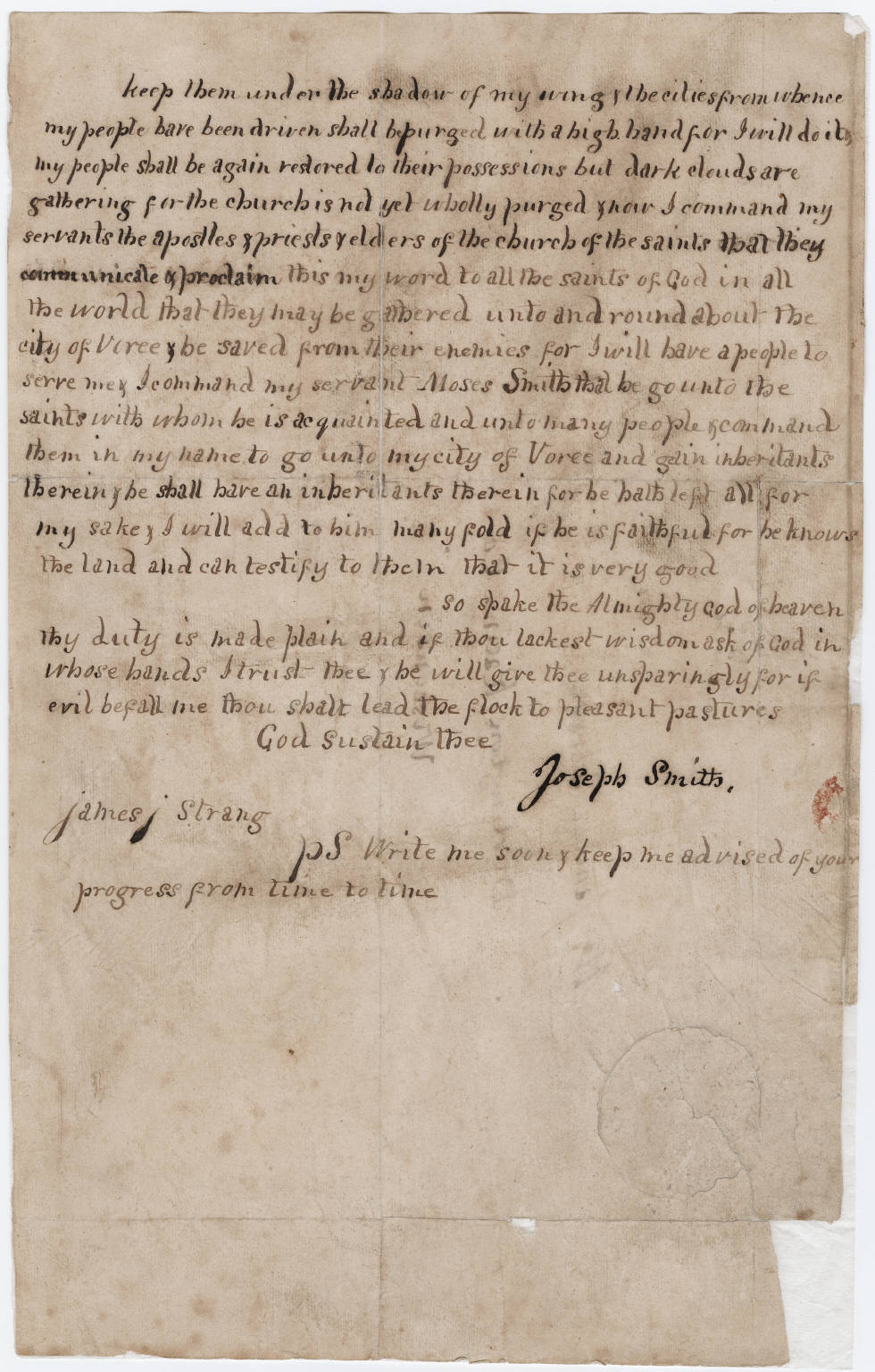James Strang’s letter of appointment
by David Walker

James Jesse Strang was crowned king of a Mormon community in Beaver Island, Michigan on July 8, 1850. In attendance were an estimated 200 members of Strang’s church, who had joined at different times, for different reasons. Some enlisted in 1844 when Strang claimed to have received a letter appointing him Joseph Smith’s successor; others in 1845, after Strang discovered buried plates confirming the designation of Voree, Wisconsin for Mormon settlement; and still others in 1846, when Strang launched an extensive recruitment campaign. By 1847 the church boasted some 1000 members nationally, one quarter of whom had settled in Voree. Some Strangites moved to Beaver Island in 1849 in pursuit of greater economic, social, and ecclesiastical stability, and many of these participated in the coronation.
The Beinecke Library at Yale houses the original letter of Strang’s ecclesiastical appointment, signed by Joseph Smith. One of my favorite archival encounters occurred when consulting it. A fellow researcher asked me what I was viewing. I replied that the letter declared Strang to be a leader and prophet of Mormonism, but that its origin and validity were disputed. My colleague explained that she, being clairvoyant, could tell that the letter had “caused pain, even death” in the world. It was assuredly a forgery, she said.
Save for the psychic part, the reaction is not unusual. Most scholarship, whether through textual criticism, handwriting analysis, character study, or inference from subsequent events, has concluded similarly: the letter is the fraudulent product of an inauthentic, self-made prophet, likely written with hopes of duping a listless and leaderless mass.
I don’t know if Strang wrote his own letter, nor do I think it necessary to care. Declarations of authenticity and determinations of forgery lead to more evaluative eddies than interpretive clarities. Even proponents of the charlatanry thesis disagree about the application of that term, and it is an ongoing debate among them whether Strang was a corrupted prophet, a thoroughgoing fake, or an opportunist-turned-believer. Making a decision between such options seems a fairly small-minded end to intellectual conversation about matters religious.
If we take religion to entail the recasting of historically contingent social conditions as intellectual heuristics and community blueprints, then people do “genuine” religious work whenever they help others situate themselves as humans relative to super- and sub-humans in place and time. More simply and necessarily, and somewhat differently, we do well to recognize that the underlying motivations for religious work need not determine the modes and extent of its reception, nor vice versa. This is not to say that the latter are uninfluenced by the institutional and symbolic creations of those in power, but rather that religious systems are created in the spaces between construction, reception, expression, and utilization. It is also to say that such systems are historically dialectical in creation, and arguably measurable in effect.
As a first step towards better metrics and longer conversations, we might usefully reconsider the inaugural epistle (here, the Letter of Appointment) as a religious genre. The proposition is simply this: that introductory letters start conversations along several fronts, in several meters. In the case of Strang’s letter of appointment, one of these did center on matters of epistolary autograph and provenance: on the curvature of the handwriting, the location of the postage stamp, and the possibility that someone had slipped supplementary material within the outermost stamped and signed sheet. But others entailed different questions and concerns of authenticity. To think about James Strang’s leadership potential or Wisconsin’s communal opportunities, for instance, relative to Brigham Young’s and Utah’s, was to think also in terms of authentic possibility and chances for cooperative religious work. It was to think in terms of heuristic worth, utility as humanistic geography, and capacity for social implementation. Strang used his first letter to induce reconsideration of Mormon social and geographical possibilities, and his accomplishments are best traced in terms of evolving dialogical exchanges around these topics than in terms of his supposed charlatanry.
Thankfully the Beinecke Library houses hundreds of letters written to, from, and around Strang—letters written between ecclesiastical leaders, among potential converts, and to other interested parties. The 1844 Letter of Appointment was part of that epistolary history and exchange, but it was only just that: an inaugural moment, a conversation starter rather than stopper. So should it be for us.